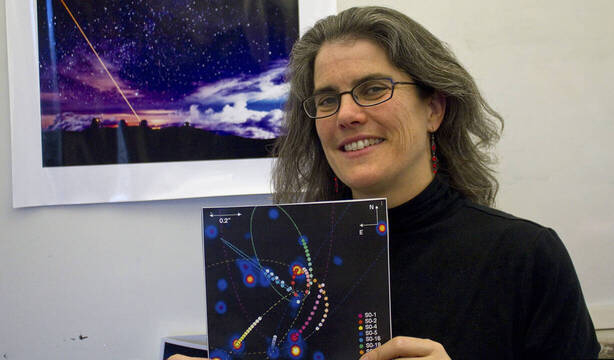The Galactic Center: a unique laboratory for the study of black holes
Andrea Ghez, Nobel Prize in Physics 2020, will give an online conference on the center of the Milky Way next Thursday, October 29
Black holes, “the darkest secrets in the universe” were the protagonists of the 2020 Nobel Prize in Physics. Andrea Ghez, a researcher at the University of California, and Reinhard Genzel, from the Max Planck Institute, shared half the prize for “discovering a supermassive compact object in the center of our galaxy ”, while the other half was awarded to Roger Penrose of the University of Oxford,“ for discovering that black hole formation is a robust prediction of the general theory of relativity ”. The Institute of Astrophysics of Andalusia (IAA-CSIC) will host next Thursday, October 29 at 6:00 p.m. an online conference given by Andrea Ghez on the center of the Milky Way, an extraordinary laboratory for the study of the physics and astrophysics of the supermassive black holes. It is an activity within the framework of the IAA's Severo Ochoa project.

The proximity of our Galaxy's center presents a unique opportunity to study a galactic nucleus with orders of magnitude higher spatial resolution than can be brought to bear on any other galaxy. After more than a decade of diffraction-limited imaging on large ground-based telescopes, the case for a supermassive black hole at the Galactic center has gone from a possibility to a certainty, thanks to measurements of individual stellar orbits. The rapidity with which these stars move on small-scale orbits indicates a source of tremendous gravity and provides the best evidence that supermassive black holes, which confront and challenge our knowledge of fundamental physics, do exist in the Universe. This work was made possible through the use of speckle imaging techniques, which corrects for the blurring effects of the earth's atmosphere in post-processing and allowed the first diffraction-limited images to be produced with these large ground-based telescopes.
Further progress in high-angular resolution imaging techniques on large, ground- based telescopes has resulted the more sophisticated technology of adaptive optics, which corrects for these effects in real time. This has increased the power of imaging by an order of magnitude and permitted spectroscopic study at high resolution on these telescopes for the first time. With adaptive optics, high resolution studies of the Galactic center have shown that what happens near a supermassive back hole is quite different than what theoretical models have predicted, which changes many of our notions on how galaxies form and evolve over time. By continuing to push on the cutting-edge of high-resolution technology, we have been able to capture the orbital motions of stars with sufficient precision to test Einstein’s General theory of Relativity in a regime that has never been probed before.
The center of the Milky Way at the IAA-CSIC
The environment of Sagittarius A * constitutes a prominent field of study at the Institute of Astrophysics of Andalusia. Specifically, the Galactic Center Group, coordinated by Rainer Schödel, published in 2019 a survey with an unprecedented resolution of the central regions of our galaxy that revealed their complete history of star formation. As part of the GalacticNucleus project, funded by the European Union, it is the most extensive census of stars of the galactic nucleus recorded to date.
Schödel published together with Reinhard Genzel in 2002 the first complete orbit of a star around Sagittarius A *, and has been collaborating with Ghez for a decade. In 2019 they published the results of the study of the star S2 over twenty-six years, which made it possible to study gravity in extreme environments, or in 2012 they announced the finding of S0-102, the star closest to the black hole.
Instituto de Astrofísica de Andalucía (IAA-CSIC)
Unidad de Divulgación y Comunicación
Silbia López de Lacalle - sll[arroba]iaa.es - 958230532
http://www.iaa.es
http://www-divulgacion.iaa.es

